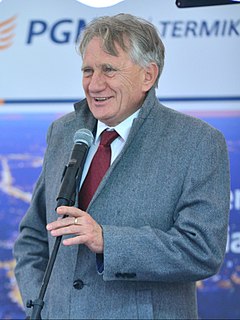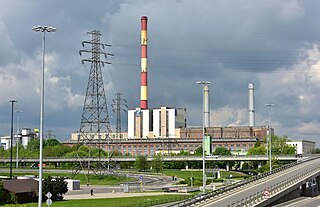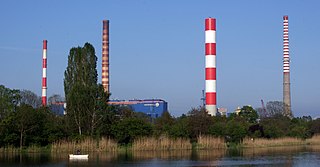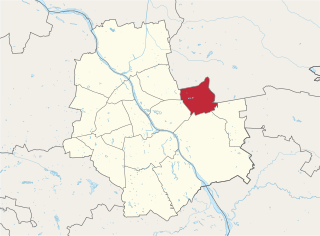
Pruszków(listen) is a city in central Poland, situated in the Masovian Voivodeship since 1999. It was previously in Warszawa Voivodeship (1975–1998). Pruszków is the capital of Pruszków County, located along the western edge of the Warsaw urban area. The town's population has grown significantly, from 16,000 in the early part of the 20th century to 60,068 in the 2014 census by the Central Statistical Office of Poland.

Cogeneration or combined heat and power (CHP) is the use of a heat engine or power station to generate electricity and useful heat at the same time. Trigeneration or combined cooling, heat and power (CCHP) refers to the simultaneous generation of electricity and useful heating and cooling from the combustion of a fuel or a solar heat collector. The terms cogeneration and trigeneration can be also applied to the power systems generating simultaneously electricity, heat, and industrial chemicals – e.g., syngas or pure hydrogen.
Fortum Oyj is a Finnish state-owned energy company focusing on the Nordic and Baltic countries, Poland, Russia and India. Fortum operates power plants, including co-generation plants, and generates and sells electricity and heat. The company also sells waste services such as recycling, reutilisation, final disposal solutions and soil remediation and environmental constructions services, and other energy-related services and products e.g. consultancy services for power plants and electric vehicle charging. Fortum is listed on the NASDAQ OMX Helsinki stock exchange and shares the number one position in the Carbon Disclosure Project's (CDP) Nordic climate index.

District heating is a system for distributing heat generated in a centralized location through a system of insulated pipes for residential and commercial heating requirements such as space heating and water heating. The heat is often obtained from a cogeneration plant burning fossil fuels or biomass, but heat-only boiler stations, geothermal heating, heat pumps and central solar heating are also used, as well as heat waste from nuclear power electricity generation. District heating plants can provide higher efficiencies and better pollution control than localized boilers. According to some research, district heating with combined heat and power (CHPDH) is the cheapest method of cutting carbon emissions, and has one of the lowest carbon footprints of all fossil generation plants. Fifth generation district heat networks do not use combustion on-site and have zero emissions of CO2 and NO2 on-site; they employ heat transfer which uses electricity which may be generated from renewable energy, or from remote fossil fuelled power stations. A combination of CHP and centralized heat pumps are used in the Stockholm multi energy system. This allows the production of heat through electricity when there is an abundance of intermittent power production and cogeneration of electric power and district heating when the availability of intermittent power production is low.

Micro combined heat and power or micro-CHP or mCHP is an extension of the idea of cogeneration to the single/multi family home or small office building in the range of up to 50 kW. Local generation has the potential for a higher efficiency than traditional grid-level generators since it lacks the 8-10% energy losses from transporting electricity over long distances. It also lacks the 10–15% energy losses from heat transfer in district heating networks due to the difference between the thermal energy carrier and the colder external environment. The most common systems use natural gas as their primary energy source and emit carbon dioxide.

Pruszków County is a unit of territorial administration and local government (powiat) in Masovian Voivodeship, east-central Poland. It came into being on January 1, 1999, as a result of the Polish local government reforms passed in 1998. Its administrative seat and largest town is Pruszków, which lies 15 kilometres (9 mi) west of Warsaw. The county also contains the towns of Piastów, lying 4 km (2 mi) north-east of Pruszków, and Brwinów, 7 km (4 mi) south-west of Pruszków.
Polskie Górnictwo Naftowe i Gazownictwo SA (en: Polish Mining and Gas Extraction Company is a Polish state-controlled oil and gas company, headquartered in Warsaw, Poland. The Company has branches and representative offices in Russia, Pakistan, Belarus and Ukraine and holds equity interests in some 30 subsidiaries, including providers of specialist geophysical, drilling and well services.
This refers to the Directive on the promotion of cogeneration based on a useful heat demand in the internal energy market and amending Directive 92/42/EEC, officially 2004/8/EC and popularly better known as the 'Combined Heat and Power (CHP) Directive'.
The Baltic Pipe is a proposed natural gas pipeline between Denmark and Poland. When completed, it will transport natural gas from Norway to Poland via Denmark.

Grain Power Station is a CCGT power station and former oil-fired power station in Kent, England, with operational capacity of 1,275 megawatts (1,710,000 hp) owned by Uniper.
Energy recycling is the energy recovery process of utilizing energy that would normally be wasted, usually by converting it into electricity or thermal energy. Undertaken at manufacturing facilities, power plants, and large institutions such as hospitals and universities, it significantly increases efficiency, thereby reducing energy costs and greenhouse gas pollution simultaneously. The process is noted for its potential to mitigate global warming profitably. This work is usually done in the form of combined heat and power or waste heat recovery.

Piotr Grzegorz Woźniak is a Polish public servant and geologist. Between 2005–2007 he served as Minister of Economy, between 2011–2013 he was Undersecretary of State at the Ministry of Environment and Chief State Geologist, since 2016 he has been serving as President of the Management Board of the Polish Oil and Gas Company (PGNiG).

Żerań Heat Power Station is a coal-fired heat power station in Białołęka, Warszawa, Poland. Built between 1952 and 1956 to Soviet design specifications – with the first turbine becoming operational on 21 July 1954 – it underwent modernisation in the years 1997-2001 when it was taken over by Vattenfall. It is now owned by PGNiG. The station has a heat generation capacity of 1,561 MW and an electric generation capacity of 350 MW.

Siekierki Power Station is a combined heat and power plant at Augustówka in Warsaw, Poland. It has an installed heat capacity of 2,081 MW and power generation capacity of 622 MW. Construction work on the station started in 1958, and in 1961 the first 50 MW unit went in service. Three further units followed in 1962, increasing its power to 200 MW.

In 2009, Poland was world's 9th largest hard coal producer. The country is also the second largest coal consumer in Europe behind Germany.
The German National Renewable Energy Action Plan is the National Renewable Energy Action Plan (NREAP) for Germany. The plan was commissioned under EU Renewable Energy Directive 2009/28/EC which required member states of the European Union to notify the European Commission with a road map. The report describes how Germany plans to achieve its legally binding target of an 18% share of energy from renewable sources in gross final consumption of energy by 2020.
The oil industry in Poland began with the first oil well in the world, at Bóbrka Field in 1853, followed by the first refinery in 1854. Poland was the third most productive nation in the world in 1900. But, due to occupations by Nazis and then Soviets, it now has only a small, mostly state-owned component, with production from its Permian Basin in the west, small and very old fields in the Carpathians in the south, and offshore in the Baltic Sea. For natural gas the country is almost completely dependent on legacy pipelines from the former Soviet Union.

Będzin Power Station is a cogeneration plant in Będzin, Silesian Voivodeship, Poland.

Warden Energy Centre is a power station owned by Markham District Energy Incorporated situated at the northwest corner of Warden Avenue and Highway 407 in King, Ontario, Canada. The 5.2 MW CHP plant uses natural gas to power 2 Caterpillar G3612 natural gas driven reciprocating engine generator.

U.S. President Donald Trump delivered a public speech in front of the Warsaw Uprising Monument at Krasinski Square, in Warsaw, the capital of Poland on July 6, 2017. During the speech, Donald Trump argued the future of Western freedom is at stake and called to defend the Western civilization against the threats of “terrorism and extremism.”
















